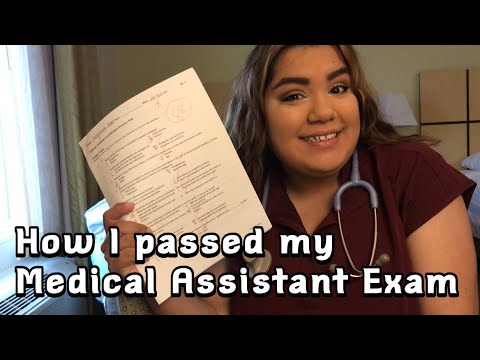How to Become a Medical Assistant: Training and Certification
Contents [show]
How to Become a medical assistant Training and Certification. Get the medical assistant training and certification you need to start your career in this high-demand healthcare field.
Checkout this video:
Introduction
Medical assistants are in demand! According to the Bureau of Labor Statistics, employment of Medical Assistants is projected to grow 19 percent from 2016 to 2026, much faster than the average for all occupations. This growth is expected due to an increase in the number of aging baby boomers and their need for medical services.
As our population continues to age, the demand for medical assistants will continue to grow. Medical assistants play a vital role in our healthcare system, providing essential support to doctors and other medical professionals. If you’re interested in a career in healthcare, becoming a medical assistant is a great place to start.
In this guide, we’ll cover everything you need to know about becoming a medical assistant, including training and certification requirements.
What is a Medical Assistant?
A medical assistant is a multi-skilled professional who works closely with physicians, nurses and other health care providers to provide direct patient care. Medical assistants perform both clinical and administrative tasks in a variety of health care settings. They may take patients’ vital signs, administer medications and injections, prepare and maintain exam rooms, schedule appointments, collect and process lab specimens, perform basic laboratory tests, code and file insurance forms, and instruct patients on follow-up care.
Medical assistants must be able to perform their duties with compassion, sensitivity and tact. They must also have excellent communication skills to interact effectively with patients, families, physicians and other health care providers.
Duties of a Medical Assistant
Medical assistants are unlicensed personnel who perform non-invasive routine technical and clerical tasks in an outpatient or medical office setting, under the direct supervision of a licensed physician or registered nurse. They work in all medical office settings including physicians’ offices, HMOs, hospitals, clinics, and other healthcare facilities.
The duties of medical assistants vary from office to office, depending on the size and location of the practice and the particular needs of the physician or physicians they work for. In small practices, medical assistants usually do a little bit of everything – from scheduling appointments and updating patient records to taking X-rays and configuring laboratory equipment. In larger practices they may specialize in one area or another. The following are some common duties of medical assistants:
Answering telephones
Scheduling appointments
Preparing patients for examination
Taking patient histories
Checking vital signs
Drawing blood
Administering medications
Performing basic lab tests
Instructing patients about medication and special diets
Supplying patients with crutches or other walking devices Authorizing insurance forms
Billing and coding insurance forms
Education and Training Requirements
In order to become a medical assistant, you will need to complete an accredited training program and earn a certificate or diploma. Some programs may also require you to pass a state-approved examination. Once you have completed your training, you will be able to apply for medical assistant positions at doctor’s offices, clinics, and other healthcare facilities.
Certification
There are several different ways to become a certified medical assistant, but the most common path is to complete an accredited postsecondary education program and then pass a certification exam. Some states have certification requirements that are more stringent than the national standards, so it’s important to check with your state’s licensing board to see what is required.
Several professional organizations offer certification for medical assistants, but the most widely recognized credential is the Certified Medical Assistant (CMA) designation from the American Association of Medical Assistants (AAMA). To earn this credential, candidates must graduate from an accredited medical assisting program and pass the CMA Exam. The AAMA also offers a Registered Medical Assistant (RMA) credential for those who do not wish to take the exam or who cannot meet the CMA eligibility requirements.
The National Healthcareer Association (NHA) also offers a Certified Clinical Medical Assistant (CCMA) credential that does not require passing an exam. To be eligible, candidates must have completed an accredited medical assistant program or have at least one year of full-time work experience as a medical assistant.
earing any of these credentials indicates that a medical assistant has met certain educational and professional standards and is qualified to perform the duties of the job. Employers often prefer to hire candidates who are certified, and some states may require certification as a condition of employment. Certification also gives medical assistants a competitive edge when seeking jobs or promotions.
Salary and Job Outlook
The median salary for medical assistants was $33,610 in 2017, with the top 10 percent earning more than $47,080.3 This occupation is expected to grow much faster than average, with 29 percent growth projected from 2016 to 2026.4 Jobs will open up due to the growth of the aging baby-boom population and their increased need for medical services. In addition, as physicians expand their practices to include more patients, they will hire more assistants.
Steps to Becoming a Medical Assistant
As the healthcare industry continues to grow, so does the demand for medical assistants. Medical assistants are multi-skilled professionals who perform both clinical and administrative duties in a variety of healthcare settings. If you’re thinking about entering this rewarding profession, here are some steps to get you started.
1.Research medical assistant programs
The first step is to research medical assistant programs at schools in your area or online. Training programs typically last from 6 to 18 months and include both classroom and hands-on instruction.
2.Complete an accredited program
Second, you’ll need to complete an accredited program. Medical assisting programs are available at community colleges, vocational schools, and some universities. To be sure your program meets industry standards, look for one that’s been accredited by the Commission on Accreditation of Allied Health Education Programs (CAAHEP) or the Accrediting Bureau of Health Education Schools (ABHES).
3.Pass the certification exam
Once you’ve completed an accredited program, you’ll be eligible to take the certification exam administered by either the American Association of Medical Assistants (AAMA) or the National Healthcare Association (NHA). Passing either exam will earn you the credential of Certified Medical Assistant (CMA). Some states also have certification exams for medical assistants.
4.Apply for a state license (if applicable)
If your state requires it, apply for a state license. While most states don’t currently require licensure for medical assistants, that may change in the future as the scope of practice for medical assistants continues to expand.
5.Look for job openings and submit your resume
Once you have your CMA credential and state license (if required), you can start looking for job openings in healthcare facilities in your area. When you find a position that interests you, submit your resume and application materials as directed by the employer
Medical Assistant Programs
Medical assisting is one of the fastest-growing careers in the United States and there are many medical assistant programs to choose from. The first step in becoming a medical assistant is completing an accredited training program. Once you have completed a program, you will then need to pass a certification exam to earn your credential.
There are many different types of medical assistant programs, and the one you choose will depend on your individual needs and goals. Some programs can be completed in as little as eight weeks, while others may take up to two years to complete. There are also online and hybrid programs available if you need more flexibility in your schedule.
The most important thing to look for when choosing a medical assistant program is accreditation. All programs must be accredited by an accrediting body recognized by the U.S. Department of Education in order to be eligible for federal financial aid. Once you have found a few accredited programs that meet your needs, you can then start looking at tuition and other costs associated with each program.
Once you have completed a medical assistant program, you will then need to pass a certification exam to earn your credential. The two main exams for medical assistants are the Certified Medical Assistant (CMA) exam offered by the American Association of Medical Assistants (AAMA), and the Registered Medical Assistant (RMA) exam offered by the American Medical Technologists (AMT). Both exams are widely recognized by employers and will allow you to practice in any state in the country.
Externships
An externship is a period of on-the-job training that takes place after you have completed your formal education and before you start your career. Many employers prefer to hire candidates who have completed an externship, and some will even require it. If you are interested in becoming a medical assistant, you should look for an externship that matches your interests and skills.
Externships are typically unpaid, but they provide you with the opportunity to get hands-on experience in the field. You will also be able to network with employers and build your résumé. If you cannot find an externship, consider volunteering at a hospital or clinic.
Jobshadowing
Shadowing a medical assistant is one of the best ways to learn about the day-to-day duties of the job. It also allows you to see if this is the right career for you. Many community colleges offer medical assistant programs that include job shadowing as part of the curriculum. You can also arrange to shadow a medical assistant at a local hospital or doctor’s office.







